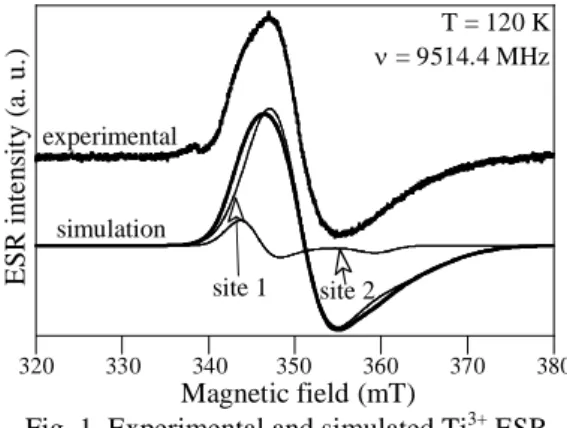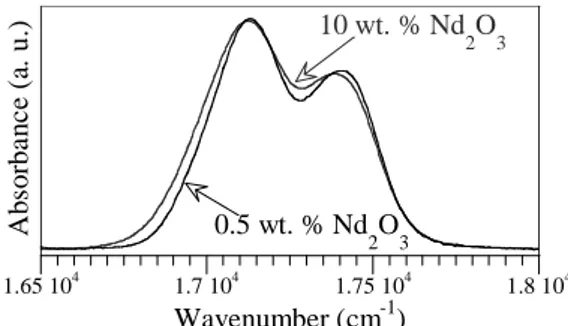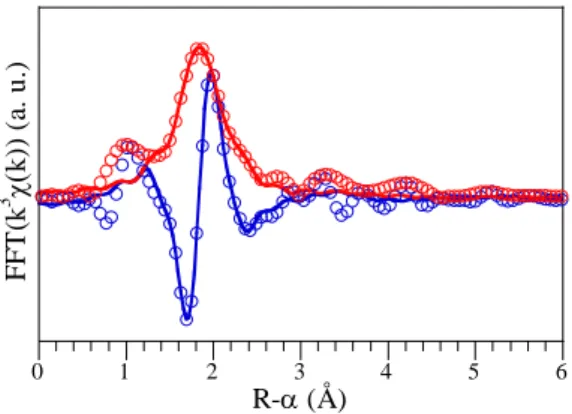HAL Id: hal-00177955
https://hal.archives-ouvertes.fr/hal-00177955
Submitted on 9 Oct 2007
HAL is a multi-disciplinary open access
archive for the deposit and dissemination of
sci-entific research documents, whether they are
pub-lished or not. The documents may come from
teaching and research institutions in France or
L’archive ouverte pluridisciplinaire HAL, est
destinée au dépôt et à la diffusion de documents
scientifiques de niveau recherche, publiés ou non,
émanant des établissements d’enseignement et de
recherche français ou étrangers, des laboratoires
parent glasses designed for the preparation of
zirconolite-based glass-ceramic waste forms
P. Loiseau, Daniel Caurant, K. Dardenne, S. Mangold, M. Denecke, J. Rothe,
N. Baffier, C. Fillet
To cite this version:
P. Loiseau, Daniel Caurant, K. Dardenne, S. Mangold, M. Denecke, et al.. Characterisation of
Nd-doped calcium aluminosilicate parent glasses designed for the preparation of zirconolite-based
glass-ceramic waste forms. ATALANTE 2004 ( Advances for future nuclear fuel cycles), Jun 2004, Nîmes,
France. �hal-00177955�
Characterisation of Nd-doped calcium aluminosilicate parent glasses designed for the preparation of zirconolite-based glass-ceramic waste forms
P. Loiseau1, D. Caurant1, K. Dardenne2, S. Mangold3, M. Denecke2, J. Rothe2, N. Baffier1, C. Fillet4
1 LCAES (CNRS UMR 7574), ENSCP, 11 rue P. et M. Curie, 75231 Paris Cedex 05, France
pascal-loiseau@enscp.jussieu.fr
2 Forschungszentrum Karlsruhe GmbH, INE, Hermann-von-Helmoltz-Platz , D-76344 Eggenstein-Leopoldshafen, Germany
3 Forschungszentrum Karlsruhe GmbH, ISS, Hermann-von-Helmoltz-Platz , D-76344 Eggenstein-Leopoldshafen, Germany
4 CEA/DEN/DIEC/SCDV, 30207 Bagnols-sur-Cèze, France
Abstract – Zirconolite-based (nominally CaZrTi2O7) glass-ceramics belonging to the SiO2-Al2O3 -CaO-ZrO2-TiO2 system are good waste forms for the specific immobilisation of actinides. The understanding of their crystallisation processes implies to investigate the structure of the glass. Thus, the environment around Ti, Zr (nucleating agents) and Nd (trivalent actinides surrogate) was characterised in parent glasses. Electron spin resonance (ESR) study of the small amount of Ti3+ occurring in the glass enabled to identify two types of sites for titanium: the main one is of C4v or D4h symmetry. EXAFS showed that Zr occupied a quite well defined 6-7-fold coordinated site with second neighbours which could correspond to Ca/Ti and Zr. Nd environment was probed by optical spectroscopies (absorption, fluorescence), ESR and EXAFS. All these techniques demonstrated that the environment around Nd was very constrained by the glassy network. Notably, Nd occupies a highly distorted 8-9-fold coordinated site in the parent glass.
INTRODUCTION
Zirconolite (CaZrTi2O7) is a naturally occurring
phase which exhibits an excellent chemical durability and a good actinide containment capacity. Therefore, this crystalline phase is a waste form of choice for the specific
immobilisation of minor actinides (mainly responsible for the long-term radiotoxicity of reprocessed high level nuclear waste) or of plutonium. An alternative to the ceramic route is to prepare zirconolite crystals by controlled crystallisation (nucleation+growth) of a parent glass. This glass-ceramic route is simpler to implement in radioactive plants and offers a greater chemical flexibility against waste composition fluctuations due to the presence of a residual glass surrounding zirconolite crystals. The basic parent glass composition which was studied is as follows (mol. %): 48.8 SiO2, 8.5
Al2O3, 25.3 CaO, 11.3 TiO2, 5.0 ZrO2, 1.1 Na2O.
This composition was determined from [1] and various loadings of Nd2O3 (trivalent actinide
surrogate) were added up to 2.2 mol. % (10 wt. %). Previous studies showed that such glasses led to the only crystallisation of zirconolite in their bulk by controlled crystallisation
(nucleation + crystal growth) [2]. However, the understanding of crystallisation processes implies to investigate the structure of the glass if further composition optimisations are to perform. This is why the environment around three
elements was characterised in these parent glasses: Ti and Zr (which play a key role in nucleation processes and which are main components of zirconolite), and Nd. EXPERIMENTAL
40g batch glasses were prepared following a standard method comprising two stages of melting and casting at 1550°C with intermediate grinding in order to increase glass homogeneity. Their compositions were checked by ICP-AES and they were perfectly amorphous. A similar glass transformation temperature around 760 °C was found for all the glasses (measured by differential thermal analysis), which means that the addition of Nd2O3 up to 2.2 mol. % has no
significant effect on the mean bond strength of the glassy network.
Due to the high preparation temperature of the glasses, a small quantity of Ti4+ ions are reduced into Ti3+ state. Contrarily to Ti4+ ions, Ti3+ ions (3d1 electron configuration) can be detected by Electron Spin Resonance (ESR). Ti3+ ESR measurements were performed at 120 K using a Bruker ESP 300e spectrometer operating at X-band (ν ≈ 9.5 GHz).
Room temperature EXAFS (Extended X-ray Absorption Fine Structure) measurements were performed at Zr-K edge (17998 eV) and Nd-L3
(Germany, Karlsruhe) in transmission mode through quenched glass samples containing 1.3 mol. % of Nd2O3 (6 wt. %) dispersed in boron
nitride pellets. EXAFS signals were extracted and simulated using the UWXAFS package [3]. Nd3+ optical properties were characterised at 15 K by absorption from 400 to 900 nm and by emission from 860 to 960 nm (4F3/2 → 4I9/2
channel). At 15 K, only the lowest energy Kramers doublet of the 4I9/2 or of the 4F3/2
multiplet is populated for absorption or emission measurements respectively.
RESULTS AND DISCUSSION
ESR study of native Ti3+ ions in parent glass During glass meting, a Ti4+ ⇔ Ti3+ equilibrium was established (displaced towards reduction with increasing temperature) and then was frozen by quenching at room temperature. Therefore, a small quantity of Ti3+, detected by ESR (Fig. 1), formed. Their amount was quantified by ESR at 120 K with a DPPH standard. For all the glasses, it was shown that the proportion of Ti at the trivalent oxidation state was below 0.7 ppm (case of the undoped glass) and decreased with increasing Nd2O3 concentration (no Ti3+ ion
detected for the 10 wt. % Nd2O3 glass). Such an
evolution is difficult to explain (Nd only exists as Nd3+ ion) but could result from an increase of the glass basicity [4] with Nd concentration, if we admit that Nd acts as a network modifier.
320 330 340 350 360 370 380 E S R in te n si ty ( a. u. ) Magnetic field (mT) experimental simulation site 2 site 1 T = 120 K ν = 9514.4 MHz
Fig. 1. Experimental and simulated Ti3+ ESR signal for the undoped glass. Ti3+ ESR signal was simulated with the assumption of an axial symmetry for simplicity reasons. Without taking into account any distribution of g factor, it was necessary to consider two contribution (with gaussian line shape) to simulate the signal and the shoulder
occurring around 344 mT. This gives evidence of two types of sites for Ti3+ ions in the glass, referred as site 1 and site 2. Results of the simulation for the undoped glass are shown in Fig. 1 and Table I. Site 2 contributes only to 8.5 % of the overall signal.
TABLE I. Results of the ESR simulation. g⊥ FWHM g⁄⁄ FWHM
Site 1 1.946 6.5 mT 1.88 12 mT Site 2 1.973 4 mT 1.89 4 mT The knowledge of the g factors gives pieces of information about the symmetry of Ti3+
environment in the glass [5]. As Ti3+ ESR signal can be detected at room temperature, several simple geometries can be excluded: tetrahedron, octahedron and tetragonally elongated
octahedron. A compressed tetrahedral symmetry can also be excluded because it would imply g⊥
< g//. An elongated tetrahedral symmetry would
impose (g// - ge)/(g⊥ - ge) = 4 (ge = 2.0023),
which could only be verified by the site 2, although a four-fold coordination is quite unlikely for a cation as big as Ti3+ (rVI(Ti3+) =
0.67 Å> rVI(Ti4+) = 0.605 Å [6]).
However, ESR results can be fully explained by considering a compressed octahedral symmetry, highly distorted to have the order g// < g⊥ (more
distorted for site 2). This geometry could correspond either to a C4v or a D4h symmetry (5
to 6 coordination number). It is interesting to notice that the C4v symmetry is the one of the
square pyramidal O=TiO4 frequently proposed
for Ti4+ environment in glasses [7].
EXAFS characterisation of Zr4+ environment in parent glass
The short range order around Zr in the 6 wt. % Nd2O3 parent glass was determined from the
simulation of the EXAFS spectrum recorded at room temperature (Fig. 2). Zr occupies a well defined site (debye-waller factor σ2 = 0.007 ±
0.001 Å-2 of 6.5 ± 0.7 coordination number with a consistent mean Zr-O distance d(Zr-O) = 2.15 ± 0.02 Å. This result shows that Zr4+ ion is able
to impose its own environment in the glass. This environment is relatively close to the one which was reported in literature for a depolymerised glass such as R7T7 glass, with a coordination number around 6 and a mean Zr-O distance ranging from 2.07 to 2.10 Å [8]. The fact that slightly higher coordination number and Zr-O distance were found in our glass could be due to
the higher polymerisation of the glassy network. For 100 moles of undoped glass, assuming that Al, Ti and Zr adopt respectively the geometries (AlO4)-, (O=TiO4)2- and (ZrO6)2-, 24.7 moles of
(CaO + Na2O) would be mobilised for their
charge compensation, so that only 1.7 moles of (CaO + Na2O) would indeed be free to
depolymerise the glassy network. In such a case, oxygens are less polarisable and a higher coordination number is required for Zr4+ charge shielding. In zirconolite, Zr coordination number is 7 and d(Zr-O) = 2.20(1) Å. This short range order similarity with the parent glass could predispose to zirconolite nucleation.
0 1 2 3 4 5 6 FF T (k 3 χ( k) ) ( a. u.) R-α (Å)
Fig. 2. Fit (solid lines) to the EXAFS (open circles) of the 6 wt. % Nd2O3 parent glass (Zr-K
edge, room temperature). The EXAFS analysis of the next nearest neighbours around Zr is complicated (Fig. 2): at least two shells (likely three) with overlapping shapes are necessary to simulate the spectrum, and they partly interfere destructively. Nevertheless, the Fourier peak around 3.2 Å seems to be associated to Ca/Ti on the one hand and Zr on the other hand, both occurring at distances around 3.5 Å from Zr.
Spectroscopic investigation of Nd3+ environment in parent glass
The fluorescence spectra corresponding to the
4F
3/2 → 4I9/2 Nd transition were recorded at 15 K
by exciting the Nd-doped glasses at the maximum of the 4I9/2→ 4F5/2 - 2H9/2 Nd
absorption band around 806.5 nm. Although the five expected emission lines cannot be resolved due to the inhomogeneous line broadening, these spectra allow to estimate the total splitting of the
4I
9/2 ground multiplet which is about 500 cm-1.
To compare, it was evaluated at 775 cm-1 for Nd-doped zirconolite samples prepared by solid state
reaction at 1460°C. The 4I9/2 splitting is a
measure of the mean crystal field experienced by Nd3+ ion in a host. The limit between compounds with low and high crystal field strength was set at 470 cm-1 by Auzel [9]. The greater crystal field of Nd in zirconolite as compared to parent glass indicates not only that the environments are different between the two hosts, but also that the mean Nd-O distance is shorter in zirconolite. Nd optical absorption spectra were recorded for the Nd-doped glasses at 15 K. They are all very similar, even though a slight broadening of absorption lines occurs with increasing Nd2O3
concentration from 0.5 to 10 wt. % (Fig. 3). Three absorption bands from 4I9/2 state are
particularly interesting: towards 2P1/2 (∼ 23200
cm-1), 4F3/2 (∼ 11400 cm-1) and 2G7/2 - 4G5/2 (∼
17200 cm-1). The first two bands (2P1/2 and 4F3/2)
notably give information about the variety of Nd environment because of the low degeneracy of the excited state, whereas the latter band (2G7/2 -
4G
5/2) is described as hypersensitive and is very
sensitive to Nd environment. For instance, the FWHM of the 4I9/2 → 2P1/2 band is approximately
150 cm-1 in Nd-doped parent glasses, much more than the one measured for zirconolite (30 cm-1), which reflects a higher distribution of
environment in the glasses.
1.65 104 1.7 104 1.75 104 1.8 104 Ab so rb an ce (a . u .) Wavenumber (cm-1) 10 wt. % Nd 2O3 0.5 wt. % Nd 2O3
Fig. 3. Portion of Nd optical absorption spectra measured at 15 K in two parent glasses (4I9/2 →
2G
7/2 - 4G5/2 transition).
Moreover, by comparison with literature [10], the shape of the 4I9/2 → 2G7/2 - 4G5/2 is structure
less (Fig. 3) and is characteristic either of highly polymerised glassy network or of glasses containing high field strength network modifiers. All these observations agree with an irregular Nd environment partly imposed by the glassy network topology, contrarily to Zr (see above). The environment of Nd was probed by EXAFS at L3 edge (6208 eV). The short range order
around Nd in the 6 wt. % Nd2O3 glass was
determined from the simulation of the EXAFS spectrum recorded at room temperature (Fig. 4).
Nd occupies a highly distorted site, the EXAFS simulation implies a cumulant analysis of the data (non-gaussian asymmetric Nd-O pair distribution [11]) with a large debye-waller factor σ2 = 0.029 ± 0.001 Å-2. Nd-O coordination
number is 8.6 ± 0.8 and the mean Nd-O distance is about 2.53 ± 0.02 Å in the glass.
0 1 2 3 4 5 6 FFT (k 3 χ( k) ) ( a. u .) R-α (Å)
Fig. 4. Fit (solid lines) to the EXAFS (open circles) of the 6 wt. % Nd2O3 parent glass (Nd-L3
edge, room temperature).
In zirconolite, Nd coordination by O is 8 and, by EXAFS, Nd-O bond distance was found to be 2.44 ± 0.01 Å with a debye-waller factor σ2 =
0.010 ± 0.001 Å-2. So, the environment around
neodymium in the glass shows striking differences with the one in the zirconolite crystalline phase and is much more distorted. Therefore, the incorporation of neodymium into zirconolite crystals during devitrification will imply strong reconstructive phenomena which are assumed to occur at high temperature, when the viscosity of the supercooled liquid is significantly lowered. In these conditions, it can be inferred that neodymium did not participate actively to the earliest steps of zirconolite nucleation processes. On the contrary,
neodymium increases diffusionnal problems and can hinder zirconolite nucleation in the parent glass.
CONCLUSION
The environment around three cations, Ti3+, Zr4+ and Nd3+ was characterised by spectroscopic techniques in aluminosilicate glasses designed for the preparation of zirconolite-based glass-ceramic waste forms.
ESR study of Ti3+ ions formed during glass melting at 1550°C revealed that their
environment could be described by a C4v or D4h
symmetry. This could correspond to a square
pyramidal O=TiO4 or to a six-fold coordinated
octahedron axially compressed. The coordination numbers involved in such geometries are close to the ones encountered in zirconolite (6 and 5) which is aimed to crystallise by heat treatment of the glasses.
Zr-K edge EXAFS spectra showed that Zr4+ ions occupied well defined 6-7 coordinated sites, close to the ones of zirconolite. This result confirms the nucleating effect of Zr which was observed on zirconolite crystallisation in the glass.
Contrarily to Zr4+ ion which can be described as a cross-linking agent that reinforces the glassy network, Nd3+ ion must rather be considered as a network modifier or a charge compensator which exhibits a lower ability to impose its own environment in a relatively polymerised glassy network. All the optical spectroscopies and EXAFS agree to describe Nd environment as being constrained by the glassy network with coordination number and Nd-O distance significantly greater than the ones of zirconolite. Therefore, Nd3+ ion cannot act as a nucleating agent for zirconolite crystallisation.
REFERENCES
1. C. FILLET, J. MARILLET, J. L.
DUSSOSSOY, F. PACAUD, N. JACQUET-FRANCILLION, J. PHALIPPOU, Ceramic
Transactions, 87, 531 (1998).
2. P. LOISEAU, D. CAURANT, O. MAJERUS, N. BAFFIER, C. FILLET, J.
Mater. Science, 38, 843 (2003).
3. M. NEWVILLE, J. Synchrotron Rad., 8, 96
(2001).
4. P. CLAES, Verre, 6(1), 33 (2000).
5. J.E. WERTZ, J.R. BOLTON, in Electron
Spin Resonance: Elementary theory and practical applications, Ed. McGraw-Hill,
Series in Advanced Chemistry (1972). 6. R.D. SHANNON, Acta Crystallogr., A32,
751 (1976).
7. G.E. BROWN Jr., F. FARGES, G. CALAS,
Rev. Mineral., 32, 317 (1995).
8. L. GALOISY, E. PELEGRIN, M.-A. ARRIO, P. ILDEFONSE, G. CALAS, D. GHALEB, C; FILLET,F. PACAUD, J. Am.
Ceram. Soc., 82(8), 2219 (1999)
9. F. AUZEL, Mat. Res. Bull., 14, 223 (1979)
10. A.A. DYMNIKOV, A.K. PRZHEVUSKII,
J. Non-Cryst. Solids, 215, 83 (1997)
11. G. DALBA, P. FORNASINI, F. ROCCA,


